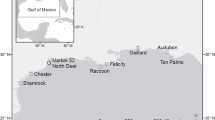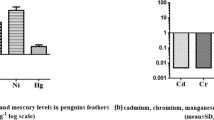Abstract
Concentrations of lead, cadmium, mercury, selenium, chromium and manganese were examined in breast feathers of shorebirds migrating north through Cape May, New Jersey in 1991 and 1992. Although we predicted that metal levels would be positively correlated with weight, this was only true for mercury in red knots (Calidris canutus). Selenium was negatively correlated with weight in red knots. No other significant correlation of metal concentrations with weight were found. Lead and mercury were highest in sanderlings (C. alba). Selenium and manganese were highest in red knots, while chromium and cadmium levels were highest in semipalmated sandpipers (C. pusilus). For 1991, interspecific metals differences were significant for all metals except lead. For semipalmated sandpipers, cadmium and chromium concentrations were significantly higher in 1991 while managese concentrations were significantly higher in 1992.
Similar content being viewed by others
References
Becker, P.H.: 1990, ‘Populations and Contamination Studies in Coastal Birds: The Common Tern Sterna hirundo’, in: Perrins, C.M., Lebreton, J.D. and Hirons, G.J.M. (eds.), Bird Population Studies: Relevance to Conservation and Management, pp. 433–460, Oxford University Press.
Braune, B.M.: 1987a, ‘Mercury Accumulation in Relation to Size and Age of Atlantic Herring (Clupea harengus harengus) from the Southwestern Bay of Fundy, Canada’, Arch. Environ. Contam. Toxicol. 16, 311–320.
Braune, B.M.: 1987b, ‘Comparison of Total Mercury Levels in Relation to Diet and Molt for Nine Species of Marine Birds’, Arch. Environ, Contam. Toxicol. 16, 217–224.
Braune, B.M. and Gaskin, D.E.: 1987, ‘Mercury Levels in Bonaparte's Gulls (Larus philadelphia) During Autumn Molt in the Quoddy Region, New Brunswick, Canada’, Arch. Environ. Contam. Toxicol. 16, 539–54.
Burger, J. and Gochfeld, M.: 1991, ‘Lead, Mercury, and Cadmium in Feathers of Tropical Terns in Puerto Rico and Australia’, Arch. Environ. Contam. Toxicol. 21, 311–315.
Burger, J., Howe, M.A., Hahn, D.C. and Chase, J.: 1977, ‘Effects of Tide Cycles on Habitat Selection and Habitat Partitioning by Migrating Shorebirds’, Auk 94, 743–758.
Connors, P.G., Myers, J.P., Connors, C.S.W. and Pitelka, F.A.: 1981, ‘Interhabitat Movements by Sanderlings in Relation to Foraging Profitability and the Tidal Cycle’, Auk 98, 49–64.
EPA: 1981, ‘Interim Methods for Sampling and Analysis of Priority Pollutants in Sediments and Fish Tissue’, US Environmental Protection Agency, EPA 600/4-81-055, Washington, DC.
Finley, M.T. and Stendell, R.C.: 1978, ‘Survival and Reproductive Success of Black Ducks Fed Methyl Mercury’, Environ. Poll. 16, 51–59.
Furness, R. and Hutton, M.: 1979, ‘Pollutant Levels in the Great Skua Catharacta skua’, Environ. Poll. 19, 261–268.
Gochfeld, M.: 1980, ‘Mercury Levels in Some Seabirds of the Humboldt Current, Peru’, Environ. Poll. 22, 197–205.
Gochfeld, M. and Burger, J.: 1982, ‘Biological Concentrations of Cadmium in Estuarine Birds of the New York Bight’, Colonial Waterbirds 5, 116–123.
Gochfeld, M., Saliva, J., Lesser, F., Shukla, T., Bertrand, D. and Burger, J.: 1991, ‘Effects of Color on Cadmium and Lead Levels in Avian Contour Feathers’, Arch. Environ. Contam. Toxicol. 20, 523–526.
Goede, A.A.: 1985, ‘Mercury, Selenium, Arsenic and Zinc in Waders from the Dutch Wadden Sea’, Environ. Poll. 37, 287–309.
Goede, A.A. and de Bruin, M.: 1985, ‘Selenium in a Shore Bird, the Dunlin, from the Dutch Waddenzee’, Marine Poll. Bull. 16, 115–117.
Goede, A.A. and de Bruin, M.: 1984, ‘The Use of Bird Feather Parts as a Monitor for Metal Pollution’, Environ. Poll. 8, 281–298.
Goede, A.A. and de Voogt, P.: 1985, ‘Lead and Cadmium in Waders from the Dutch Wadden Sea’, Environ. Poll. 37, 311–322.
Grue, C.E., Hoffman, D.J., Beyer, W.N. and Franson, L.P.: 1986, ‘Lead Concentrations and Reproductive Success in European Starlings Sturnus vulgaris Nesting Within Highway Roadside Verges’, Environ. Poll. 42, 157–182.
Grue, C.E., O'Shea, T.J. and Hoffmann, D.J.: 1984, ‘Lead Concentrations and Reproduction in Highway-nesting Barn Swallows’, Condor 86, 383–389.
Heinz, G.H. and Haseltine, S.D.: 1981, ‘Avoidance Behavior of Young Black Ducks Treated with Chromium’, Toxicol. Letters 8, 307–310.
Hoffman, D.J., Franson, J.C., Pattee, O.H., Bunck, C.M. and Anderson, A.: 1985, ‘Survival, Growth, and Accumulation of Ingested Lead in Nestling American Kestrels (Falco sparverius)’, Arch. Environ. Contam. Toxicol. 14, 89–94.
Honda, K., Min, B.Y. and Tatsukawa, R.: 1986, ‘Distribution of Heavy Metals and Their Age-Related Changes in the Eastern Great White Egret, Egretta alba modesta, in Korea’, Arch. Environ. Contam. Toxicol. 15, 185–197.
Hutton, M.: 1981, ‘Accumulation of Heavy Metals and Selenium in Three Seabird Species from the United Kingdom’, Environ. Poll. 26, 129–145.
Kraus, M.L.: 1989, ‘Bioaccumulation of Heavy Metals in Pre-Fledging Tree Swallows, Tachycineta bicolor’, Bull. Environ. Contam. Toxicol. 43, 407–414.
Lee, D.P., Honda, K., Tatsukawa, R. and Won, P.: 1989, ‘Distribution and Residue Levels of Mercury, Cadmium and Lead in Korean Birds’, Bull. Environ. Contam. Toxicol. 43, 550–555.
Lindberg, P.: 1984, ‘Mercury in Feathers of Swedish Gyrfalcons, Falco rusticolus, in Relation to Diet’, Bull. Environ. Contam. Toxicol. 32, 453–459.
Maedgen, J.L., Hacker, C.S., Schroeder, G.D. and Weir, F.W.: 1982, ‘Bioaccumulation of Lead and Cadmium in the Royal Tern and Sandwich Tern’, Arch. Environ. Contam. Toxicol. 11, 99–102.
Morrison, R.I.G. and Ross, R.K.: 1989, Atlas of Nearctic Shorebirds on the Coast of South America, Volume 1, Canadian Wildlife Service, Ottawa, Canada, pp. 27–41.
Osborn, D., Harris, M.P. and Nicholson, J.K.: 1979, ‘Comparitive Tissue Distribution of Mercury, Cadmium, and Zinc in Three Species of Pelagic Seabirds’, Comp. Biochem. Physiol. 64, 61–67.
Recher, H.F.: 1966, ‘Some Aspects of the Ecology of Migrant Shorebirds’, Ecology 47, 393–407.
Reid, M. and Hacker, C.S.: 1982, ‘Spatial and Temporal Variation in Lead and Cadmium in the Laughing Gull, Larus atricilla’, Marine Poll. Bull. 13, 387–389.
Rose, G.A. and Parker, G.H.: 1982, ‘Effects of Smelter Emissions on Metal Levels in the Plumage of Ruffed Grouse near Sudbury, Ontario, Canada’, Can. J. Zool. 60, 2659–2667.
Senner, S.E. and Howe, M.A.: 1984, ‘Conservation of Nearctic Shorebirds’, in: Burger, J. and Olla, B. (eds.), Behavior of Marine Animals, Vol. 5, pp. 379–421, Plenum Press, New York.
Siegel, S.: 1956, Nonparametric Statistics, McGraw-Hill, New York.
Shukla, G.S. and Chandra, S.V.: 1987, ‘Concurrent Exposure to Lead, Manganese, and Cadmium and Their Distribution to Various Brain Regions, Liver, Kidney, and Testis of Growing Rats’, Arch. Environ. Contam. Toxicol. 16, 303–310.
Solonen, T. and Lodenius, M.: 1990, ‘Feathers of Birds of Prey as Indicators of Mercury Contamination in Southern Finland’, Holarctic Ecol. 13, 229–237.
Spray, C.J. and Milne, H.: 1988, ‘The Incidence of Lead Poisoning Among Whooper and Mute Swans Cygnus cygnus and C. olor in Scotland’, Biol. Conserv. 44, 265–281.
Spronk, N. and Hartog, G.C.: 1970, ‘Mercury in Birds of Prey’, Ardea 59, 34–37.
Stoewsand, G.S., Bache, C.A., Gutenmann, W.H. and Lisk, D.J.: 1986, ‘Concentration of Cadmium in Coturnix Quail Fed Earthworms’, J. Toxicol. Environ. Health 18, 369–376.
Stoneburger, D.L. and Harrison, C.S.: 1981, ‘Heavy Metal Residues in Laysan Duck Feathers’, Mar. Poll. Bull. 12, 354–355.
Struger, J., Elliot, J.E. and Weseloh, D.V.: 1987, ‘Metals and Essential Elements in Herring Gulls from the Great Lakes, 1983’, J. Great Lakes Res. 13, 43–55.
Suzuki, H., Wada, O., Inoue, K., Tosaka, H. and Ono, T.: 1983, ‘Role of Brain Lysosomes in the Development of Manganese Toxicity in Mice’, Toxicol. Applied Pharmacol. 71, 422–429.
Terres, J.K.: 1980, The Audubon Society Encyclopedia of North American Birds, Alfred A. Knopf Press, New York.
Weimeyer, S.N., Jurek, R.M. and Morre, J.F.: 1986, ‘Environmental Contaminants in Surrogates, Foods, and Feathers of California Condors (Gymnogyps californianus)’, Environ. Monitor. Assess. 6, 91–111.
Author information
Authors and Affiliations
Rights and permissions
About this article
Cite this article
Burger, J., Seyboldt, S., Morganstein, N. et al. Heavy metals and selenium in feathers of three shorebird species from Delaware bay. Environ Monit Assess 28, 189–198 (1993). https://doi.org/10.1007/BF00547037
Received:
Revised:
Issue Date:
DOI: https://doi.org/10.1007/BF00547037




